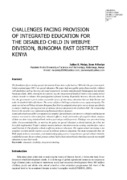| dc.description.abstract | The foundation of present day special education in Kenya dates as far back as 1968 when the government published sessional paper NO. 5 on special education. The paper laid out a public policy framework for children
with disabilities such as hearing and visual impairment, mentally and physically handicapped and multiple
handicaps (GoK, 2003). Among the key policies was the integration of disabled children into regular formal
schools in order to enhance their participation in formal learning. Regrettably however, 40 years down the
line, the government is yet to realize reasonable access of elementary education that can help liberate and
make the disabled child self-reliance. The sector still faces challenges related to access, equity and quality. The
study carried out in Webuye division, Bungoma East District, adopted a descriptive survey design specifi cally
to analyze challenges facing provision of inclusive formal education to the disabled child. The relationship
between the variables was explained using Rawlasian theory of justice.
A total of 6 schools out of 104 were purposively sampled. Questionnaires and interview schedules and document
analysis were used to collect data from education offi cers, heads and teachers of sampled schools. Analysis
of data was done using statistical tools such as percentages and frequencies. Findings were presented using
tables. It was concluded that, as much as the policy on special education is clearly laid out, for it has not
been fully implemented. People’s attitude towards inclusive education remains wanting, and therefore, only a
small fraction (3.4%) of public schools is offering inclusive education. The regular school curriculum is too
academic oriented and the teachers are yet to embrace inclusive education. The study recommends that, the
MoE adapts inclusive curriculum, examination and grading system. Comprehensive special schools should be
established to cater for pre-school, primary school, high school and technical schooling to provide meaningful
education to meet their needs. | en_US |

